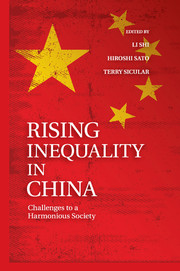Book contents
- Frontmatter
- Contents
- List of Tables
- List of Figures
- Contributors
- Preface
- Abbreviations
- Glossary
- 1 Rising Inequality in China
- 2 Overview
- 3 Housing Ownership, Incomes, and Inequality in China, 2002–2007
- 4 Educational Inequality in China
- 5 Inequality and Poverty in Rural China
- 6 The Evolution of the Migrant Labor Market in China, 2002–2007
- 7 A New Episode of Increased Urban Income Inequality in China
- 8 Unemployment and the Rising Number of Nonworkers in Urban China
- 9 Do Employees in the Public Sector Still Enjoy Earnings Advantages?
- 10 Redistributive Impacts of the Personal Income Tax in Urban China
- 11 Changes in the Gender-Wage Gap in Urban China, 1995–2007
- 12 Intertemporal Changes in Ethnic Urban Earnings Disparities in China
- Appendix I The 2007 Household Surveys
- Appendix II The 2002 and 2007 CHIP Surveys
- Index
- References
2 - Overview
Income Inequality and Poverty in China, 2002–2007
Published online by Cambridge University Press: 05 July 2013
- Frontmatter
- Contents
- List of Tables
- List of Figures
- Contributors
- Preface
- Abbreviations
- Glossary
- 1 Rising Inequality in China
- 2 Overview
- 3 Housing Ownership, Incomes, and Inequality in China, 2002–2007
- 4 Educational Inequality in China
- 5 Inequality and Poverty in Rural China
- 6 The Evolution of the Migrant Labor Market in China, 2002–2007
- 7 A New Episode of Increased Urban Income Inequality in China
- 8 Unemployment and the Rising Number of Nonworkers in Urban China
- 9 Do Employees in the Public Sector Still Enjoy Earnings Advantages?
- 10 Redistributive Impacts of the Personal Income Tax in Urban China
- 11 Changes in the Gender-Wage Gap in Urban China, 1995–2007
- 12 Intertemporal Changes in Ethnic Urban Earnings Disparities in China
- Appendix I The 2007 Household Surveys
- Appendix II The 2002 and 2007 CHIP Surveys
- Index
- References
Summary
Introduction
It has been more than three decades since China started to transform its economy institutionally and structurally. The economic transformation has stimulated rapid economic growth in both GDP and personal incomes. From 1978 to 2007 the annual growth of GDP averaged close to 10 percent and that of household per capita income more than 7 percent. The rate of economic growth was even more impressive in later years, including the period under study in this chapter. From 2002 to 2007, annual growth of GDP was 11.6 percent and of rural and urban household per capita income 6.8 and 9.6 percent, respectively.
Although the reforms were successful in promoting GDP growth, by the early 2000s, concerns about rising disparities and sustainability prompted the government to announce a new development strategy emphasizing sustainable, harmonious growth. A new policy program, referred to as the “scientific outlook on development” (kexue fazhanguan), or the “Hu-Wen New Policies” (Hu-Wen xin zheng), aimed to promote development in urban and rural areas, reduce regional disparities, narrow income inequalities, and establish a social protection network with broad coverage over most of the population. As discussed in Chapters 1 and 5, the new policy program contained a series of pro-rural measures. These included the elimination of agricultural taxes, which had been in place for almost sixty years, and the adoption of new farm subsidies, for example, for grain production, purchase of agricultural inputs, and farm insurance (Lin and Wong 2012). By the end of 2007, Chinese rural households were no longer paying agricultural taxes, and total agricultural production subsidies from the central government exceeded 50 billion yuan (Lin and Wong 2012; Ministry of Agriculture 2007).
Information
- Type
- Chapter
- Information
- Rising Inequality in ChinaChallenges to a Harmonious Society, pp. 44 - 84Publisher: Cambridge University PressPrint publication year: 2013
References
Accessibility standard: Unknown
Why this information is here
This section outlines the accessibility features of this content - including support for screen readers, full keyboard navigation and high-contrast display options. This may not be relevant for you.Accessibility Information
- 8
- Cited by
